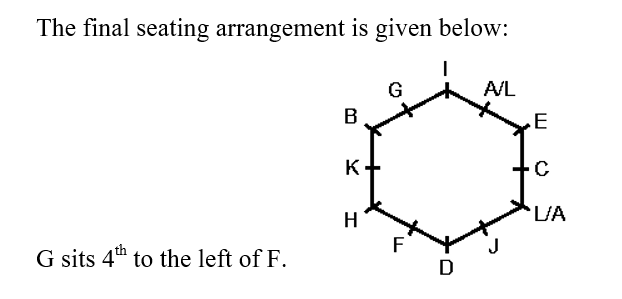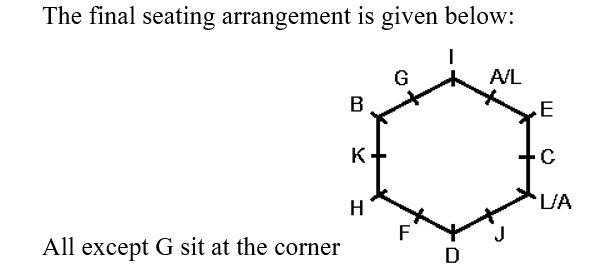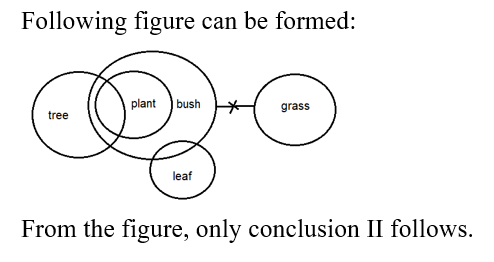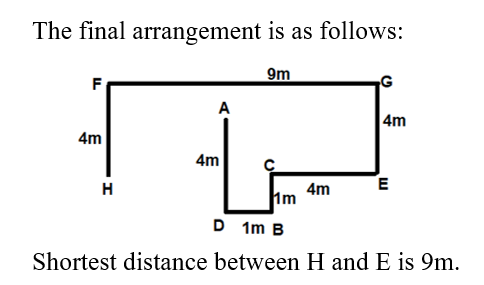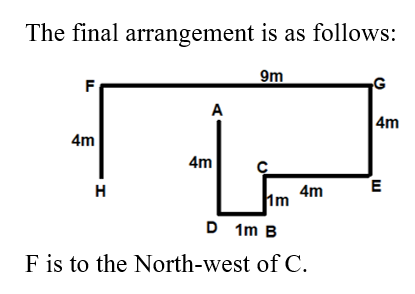Question 1:
Directions: Answer the questions based on the information given below:
निर्देश: दिए गए जानकारी के आधार पर सवालों के उत्तर दें|
12 persons (A, B, C, D, E, F, G, H, I, J, K and L) sit around a regular hexagonal shaped table. Each of them faces towards the centre. One person sits on each corner. One person sits on the middle of each side. No two persons having names starting with consecutive alphabets sit adjacent to each other.
D sits 4th to the right of B, who sit on one of the corners. Three persons sit between B and E. I sits 3rd to the right of C, who sits adjacent to E. K sits immediate left of H, who sits on one of the corners. Three persons sit between K and J. G sits opposite to J. F doesn’t sit adjacent to C.
12 व्यक्ति (A, B, C, D, E, F, G, H, I, J, K और L) एक नियमित छकोनी मेज़ पर बैठे हैं|इनमे से प्रत्येक का मुख केंद्र की ओर है| एक व्यक्ति प्रत्येक कोने पर बैठा है|एक व्यक्ति प्रत्येक भुजा के मध्य में बैठा है|वैसे कोई दो व्यक्ति एक दूसरे के बगल में नहीं बैठे हैं जिनके नाम लगातार अक्षर से शुरू होते हैं|
D, B के दाएँ से चौथे स्थान पर बैठा है और B किसी एक कोने पर बैठा है| तीन व्यक्ति B और E के बीच बैठे हैं| I, C के दाएँ से तीसरे स्थान पर बैठा है और C, E के बगल में बैठा है| K, H के तत्काल बाएं ओर बैठा है और H किसी एक कोने पर बैठा है| तीन व्यक्ति K और J के बीच बैठे है| G, J के विपरीत बैठा है| F, C के बगल में नहीं बैठा है|
What is the position of G with respect to F?
F के सन्दर्भ में G का क्या स्थान है?
Question 2:
corners. Three persons sit between K and J. G sits opposite to J. F doesn’t sit adjacent to C.
12 व्यक्ति (A, B, C, D, E, F, G, H, I, J, K और L) एक नियमित छकोनी मेज़ पर बैठे हैं|इनमे से प्रत्येक का मुख केंद्र की ओर है| एक व्यक्ति प्रत्येक कोने पर बैठा है|एक व्यक्ति प्रत्येक भुजा के मध्य में बैठा है|वैसे कोई दो व्यक्ति एक दूसरे के बगल में नहीं बैठे हैं जिनके नाम लगातार अक्षर से शुरू होते हैं|
D, B के दाएँ से चौथे स्थान पर बैठा है और B किसी एक कोने पर बैठा है| तीन व्यक्ति B और E के बीच बैठे हैं| I, C के दाएँ से तीसरे स्थान पर बैठा है और C, E के बगल में बैठा है| K, H के तत्काल बाएं ओर बैठा है और H किसी एक कोने पर बैठा है| तीन व्यक्ति K और J के बीच बैठे है| G, J के विपरीत बैठा है| F, C के बगल में नहीं बैठा है|
___ sits 4th to the right of H.
____ H के दाएँ से चौथे स्थान पर बैठा है|
Question 3:
Directions: Answer the questions based on the information given below:
निर्देश: दिए गए जानकारी के आधार पर सवालों के उत्तर दें|
12 persons (A, B, C, D, E, F, G, H, I, J, K and L) sit around a regular hexagonal shaped table. Each of them faces towards the centre. One person sits on each corner. One person sits on the middle of each side. No two persons having names starting with consecutive alphabets sit adjacent to each other.
D sits 4th to the right of B, who sit on one of the corners. Three persons sit between B and E. I sits 3rd to the right of C, who sits adjacent to E. K sits immediate left of H, who sits on one of the corners. Three persons sit between K and J. G sits opposite to J. F doesn’t sit adjacent to C.
12 व्यक्ति (A, B, C, D, E, F, G, H, I, J, K और L) एक नियमित छकोनी मेज़ पर बैठे हैं|इनमे से प्रत्येक का मुख केंद्र की ओर है| एक व्यक्ति प्रत्येक कोने पर बैठा है|एक व्यक्ति प्रत्येक भुजा के मध्य में बैठा है|वैसे कोई दो व्यक्ति एक दूसरे के बगल में नहीं बैठे हैं जिनके नाम लगातार अक्षर से शुरू होते हैं|
D, B के दाएँ से चौथे स्थान पर बैठा है और B किसी एक कोने पर बैठा है| तीन व्यक्ति B और E के बीच बैठे हैं| I, C के दाएँ से तीसरे स्थान पर बैठा है और C, E के बगल में बैठा है| K, H के तत्काल बाएं ओर बैठा है और H किसी एक कोने पर बैठा है| तीन व्यक्ति K और J के बीच बैठे है| G, J के विपरीत बैठा है| F, C के बगल में नहीं बैठा है|
Find the odd one out:
विषम का चुनाव करें|
Question 4:
Directions: Answer the questions based on the information given below:
निर्देश: दिए गए जानकारी के आधार पर सवालों के उत्तर दें|
12 persons (A, B, C, D, E, F, G, H, I, J, K and L) sit around a regular hexagonal shaped table. Each of them faces towards the centre. One person sits on each corner. One person sits on the middle of each side. No two persons having names starting with consecutive alphabets sit adjacent to each other.
D sits 4th to the right of B, who sit on one of the corners. Three persons sit between B and E. I sits 3rd to the right of C, who sits adjacent to E. K sits immediate left of H, who sits on one of the corners. Three persons sit between K and J. G sits opposite to J. F doesn’t sit adjacent to C.
12 व्यक्ति (A, B, C, D, E, F, G, H, I, J, K और L) एक नियमित छकोनी मेज़ पर बैठे हैं|इनमे से प्रत्येक का मुख केंद्र की ओर है| एक व्यक्ति प्रत्येक कोने पर बैठा है|एक व्यक्ति प्रत्येक भुजा के मध्य में बैठा है|वैसे कोई दो व्यक्ति एक दूसरे के बगल में नहीं बैठे हैं जिनके नाम लगातार अक्षर से शुरू होते हैं|
D, B के दाएँ से चौथे स्थान पर बैठा है और B किसी एक कोने पर बैठा है| तीन व्यक्ति B और E के बीच बैठे हैं| I, C के दाएँ से तीसरे स्थान पर बैठा है और C, E के बगल में बैठा है| K, H के तत्काल बाएं ओर बैठा है और H किसी एक कोने पर बैठा है| तीन व्यक्ति K और J के बीच बैठे है| G, J के विपरीत बैठा है| F, C के बगल में नहीं बैठा है|
K sits 2nd to the right of ___.
K ____ के दाएँ से दूसरे स्थान पर बैठा है|
Question 5:
Directions: Answer the questions based on the information given below:
निर्देश: दिए गए जानकारी के आधार पर सवालों के उत्तर दें|
12 persons (A, B, C, D, E, F, G, H, I, J, K and L) sit around a regular hexagonal shaped table. Each of them faces towards the centre. One person sits on each corner. One person sits on the middle of each side. No two persons having names starting with consecutive alphabets sit adjacent to each other.
D sits 4th to the right of B, who sit on one of the corners. Three persons sit between B and E. I sits 3rd to the right of C, who sits adjacent to E. K sits immediate left of H, who sits on one of the corners. Three persons sit between K and J. G sits opposite to J. F doesn’t sit adjacent to C.
12 व्यक्ति (A, B, C, D, E, F, G, H, I, J, K और L) एक नियमित छकोनी मेज़ पर बैठे हैं|इनमे से प्रत्येक का मुख केंद्र की ओर है| एक व्यक्ति प्रत्येक कोने पर बैठा है|एक व्यक्ति प्रत्येक भुजा के मध्य में बैठा है|वैसे कोई दो व्यक्ति एक दूसरे के बगल में नहीं बैठे हैं जिनके नाम लगातार अक्षर से शुरू होते हैं|
D, B के दाएँ से चौथे स्थान पर बैठा है और B किसी एक कोने पर बैठा है| तीन व्यक्ति B और E के बीच बैठे हैं| I, C के दाएँ से तीसरे स्थान पर बैठा है और C, E के बगल में बैठा है| K, H के तत्काल बाएं ओर बैठा है और H किसी एक कोने पर बैठा है| तीन व्यक्ति K और J के बीच बैठे है| G, J के विपरीत बैठा है| F, C के बगल में नहीं बैठा है|
___ sits immediate right of C.
______ C के तत्काल दाएँ ओर बैठा है|
Question 6:
In the question, assuming the given statements to be true, find which of the conclusion (s) among given three conclusions is /are definitely true and then give your answer accordingly.
निम्नलिखित प्रश्न में, दिए गए कथनों को सत्य मानकर, यह तय करना है कि दिए गए तीन निष्कर्षो में से कौन सा निष्कर्ष निश्चित रूप से सत्य है और फिर उसी अनुसार अपना उत्तर देना है।
Statements: G < R < K; A < N ≥ Y > R; V > K
Conclusions:
I. A < K
II. V > Y
III. G < V
Question 7:
In the question below there are four statements followed by three conclusions I, II and III. You have to take the three given statements to be true even if they seem to be at variance from commonly known facts and then decide which of the given conclusions logically follows from the four statements disregarding commonly known facts.
निम्नलिखित प्रश्न में चार कथन के बाद तीन निष्कर्ष I, II और III दिए गए हैं। आपको दिए गए कथन को सत्य मानना है भले ही वह ज्ञात तथ्यों से भिन्न भी हो और फिर यह तय करना है कि दिए गए निष्कर्षों में से कौन सा निष्कर्ष इन कथनों का तर्कसंगत अनुसरण करता है।
Statements: Some plant are tree.
कथन: कुछ प्लांट ट्री है।
All plant are bush.
सभी प्लांट बुश है।
No bush is grass.
कोई भी बुश ग्रास नहीं है।
Some bush are leaf.
कुछ बुश लीफ़ है।
Conclusions: I. Some tree are leaf.
निष्कर्ष: I. कुछ ट्री लीफ़ है।
II. No plant is grass.
II. कोई भी प्लांट ग्रास नहीं है।
III. Some leaf are plant.
III. कुछ leaf प्लांट है।
Question 8:
Directions : Answer the questions based on the information given below:
निर्देश: दिए गए जानकारी के आधार पर सवालों के उत्तर दें।
Eight items, A, B, C, D, E, F, G and H are placed at some distance from each other.
A is placed 4m north to D, which is 1m west to B, which is 1m south to C. H is placed 4m south to F, which is 9m west to G, which is 4m north to E. C is placed 4m west to E.
आठ वस्तु, A, B, C, D, E, F, G और H को एक दूसरे से कुछ दुरी पर रखा गया है।
A, D के 4मी उत्तर में है और D, B के 1मी पश्चिम में है और B, C के 1मी दक्षिण में है। H, F के 4मी दक्षिण में है और F, G के 9मी पश्चिम में है और G, E के 4मी उत्तर में है। C, E के 4मी पश्चिम में है।
What is the shortest distance between H and E?
H और E के बीच की न्यूनतम दूरी कितनी है?
Question 9:
Directions : Answer the questions based on the information given below:
निर्देश: दिए गए जानकारी के आधार पर सवालों के उत्तर दें।
Eight items, A, B, C, D, E, F, G and H are placed at some distance from each other.
A is placed 4m north to D, which is 1m west to B, which is 1m south to C. H is placed 4m south to F, which is 9m west to G, which is 4m north to E. C is placed 4m west to E.
आठ वस्तु, A, B, C, D, E, F, G और H को एक दूसरे से कुछ दुरी पर रखा गया है।
A, D के 4मी उत्तर में है और D, B के 1मी पश्चिम में है और B, C के 1मी दक्षिण में है। H, F के 4मी दक्षिण में है और F, G के 9मी पश्चिम में है और G, E के 4मी उत्तर में है। C, E के 4मी पश्चिम में है।
What is the direction of F with respect to C?
C के सन्दर्भ में F किस दिशा में है?
Question 10:
In the question below there are three statements followed by three conclusions I, II and III. You have to take the three given statements to be true even if they seem to be at variance from commonly known facts and then decide which of the given conclusions logically follows from the three statements disregarding commonly known facts.
निम्नलिखित प्रश्न में तीन कथन के बाद तीन निष्कर्ष I, II और III दिए गए हैं। आपको दिए गए कथन को सत्य मानना है भले ही वह ज्ञात तथ्यों से भिन्न भी हो और फिर यह तय करना है कि दिए गए निष्कर्षों में से कौन सा निष्कर्ष इन कथनों का तर्कसंगत अनुसरण करता है।
Statements: Only bee is insect.
कथन: केवल बी इन्सेक्ट है।
Some bee are ant.
कुछ बी एन्ट है।
Each ant is wasp.
प्रत्येक एन्ट वास्प है।
Conclusions: I. All insect are bee.
निष्कर्ष: I. सभी इन्सेक्ट बी है।
II. Some wasp are insect.
II. कुछ वास्प इन्सेक्ट है।
III. Some bee are wasp.
III. कुछ बी वास्प है।

